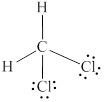
Concept explainers
(a)
Interpretation:
Lewis structure for the
Concept introduction:
Lewis structure is a convenient way to convey information such as which atoms are bonded to each other by which type of bond. Only valence electrons take part to draw Lewis structure.
Valence electrons that participate in bond formation are called bonding electron pairs whereas electrons that do not take part in bonding and that remain as non-bonding electrons are termed as lone pair of electrons.
Lewis structure is drawn from the total valence electron count of each atom in the molecule. Skeleton structure for the given molecule is drawn with atoms bonded with a single bond, the central atom is always less electronegative atom. Electrons that participate in forming the bond are bonding electrons. Remaining electrons are distributed first to outer atoms such that each atom completes its octet other than hydrogen.
Answer to Problem 1.44P
Lewis structure for

Explanation of Solution
The given molecule
Thus the skeleton structure for

Remaining two valence electrons are contributed as lone pair of electrons to the outer atom which is nitrogen.
Hence the complete Lewis structure for

Lewis structure for
(b)
Interpretation:
Lewis structure for
Concept introduction:
Lewis structure is drawn from the total valence electron count of each atom in the molecule. Skeleton structure for the given molecule is drawn with atoms bonded with a single bond, the central atom is always less electronegative atom. Electrons that participate in forming the bond are bonding electrons. Remaining electrons are distributed first to outer atoms such that each atom complete its octet other than hydrogen.
Answer to Problem 1.44P
Lewis structure for

Explanation of Solution
In

Remaining

Lewis structure for
(c)
Interpretation:
Lewis structure for
Concept introduction:
Lewis structure is drawn from the total valence electron count of each atom in the molecule. Valence electrons participate in bond formation are called bonding electron pairs whereas electrons that do not take part in bonding and that remain as non-bonding electrons are termed as lone pair of electrons. Skeleton structure for the given molecule is drawn with atoms bonded with a single bond, the central atom is always less electronegative atom.
Lone pair of electrons contributed to outer atoms to complete octet except hydrogen.
Answer to Problem 1.44P
The Lewis structure for

Explanation of Solution
Carbon is the central atom in

Remaining six electrons are contributed as lone pairs to the outer atom oxygen but one electron is involved in bonding with complete octet of oxygen atom.

Lewis structure is drawn from the total valence electron count.
(d)
Interpretation:
Lewis structure for
Concept introduction:
Lewis structure is drawn from the total valence electron count of each atom in the molecule. Skeleton structure for the given molecule is drawn with atoms bonded with a single bond, the central atom is always less electronegative atom. Electrons that participate in forming the bond are bonding electrons. Remaining electrons are distributed first to outer atoms such that each atom completes its octet other than hydrogen.
Answer to Problem 1.44P
Lewis structure for

Explanation of Solution
In

Eight electrons from total
Therefore the Lewis structure for

Lewis structure is drawn from total valence electron count.
(e)
Interpretation:
Lewis structure for
Concept introduction:
Lewis structure is drawn from the total valence electron count of each atom in the molecule. Valence electrons that participate in bond formation are called bonding electron pairs whereas electrons that do not take part in bonding and that remain as non-bonding electrons are termed as lone pair of electrons. Skeleton structure for the given molecule is drawn with atoms bonded with a single bond, the central atom is always less electronegative atom.
Lone pair of electrons contributed to outer atoms to complete octet except hydrogen.
Answer to Problem 1.44P
Lewis structure for
![]()
Explanation of Solution
The given molecule
![]()
Remaining
Hence the Lewis structure for
![]()
Lewis structure is drawn from total valence electron count.
Want to see more full solutions like this?
Chapter 1 Solutions
EBK ORGANIC CHEMISTRY: PRINCIPLES AND M
- Calculate the pH and the pOH of each of the following solutions at 25 °C for which the substances ionize completely: (a) 0.000259 M HClO4arrow_forwardWhat is the pH of a 1.0 L buffer made with 0.300 mol of HF (Ka = 6.8 × 10⁻⁴) and 0.200 mol of NaF to which 0.160 mol of NaOH were added?arrow_forwardDetermine if the following salt is neutral, acidic or basic. If acidic or basic, write the appropriate equilibrium equation for the acid or base that exists when the salt is dissolved in aqueous solution. If neutral, simply write only NR. Be sure to include the proper phases for all species within the reaction. NaN₃arrow_forward
- A. Draw the structure of each of the following alcohols. Then draw and name the product you would expect to produce by the oxidation of each. a. 4-Methyl-2-heptanol b. 3,4-Dimethyl-1-pentanol c. 4-Ethyl-2-heptanol d. 5,7-Dichloro-3-heptanolarrow_forwardWhat is the pH of a 1.0 L buffer made with 0.300 mol of HF (Ka = 6.8 × 10⁻⁴) and 0.200 mol of NaF to which 0.160 mol of NaOH were added?arrow_forwardCan I please get help with this.arrow_forward
- Determine if the following salt is neutral, acidic or basic. If acidic or basic, write the appropriate equilibrium equation for the acid or base that exists when the salt is dissolved in aqueous solution. If neutral, simply write only NR. Be sure to include the proper phases for all species within the reaction. N₂H₅ClO₄arrow_forwardPlease help me with identifying these.arrow_forwardCan I please get help with this?arrow_forward
 Introduction to General, Organic and BiochemistryChemistryISBN:9781285869759Author:Frederick A. Bettelheim, William H. Brown, Mary K. Campbell, Shawn O. Farrell, Omar TorresPublisher:Cengage Learning
Introduction to General, Organic and BiochemistryChemistryISBN:9781285869759Author:Frederick A. Bettelheim, William H. Brown, Mary K. Campbell, Shawn O. Farrell, Omar TorresPublisher:Cengage Learning
